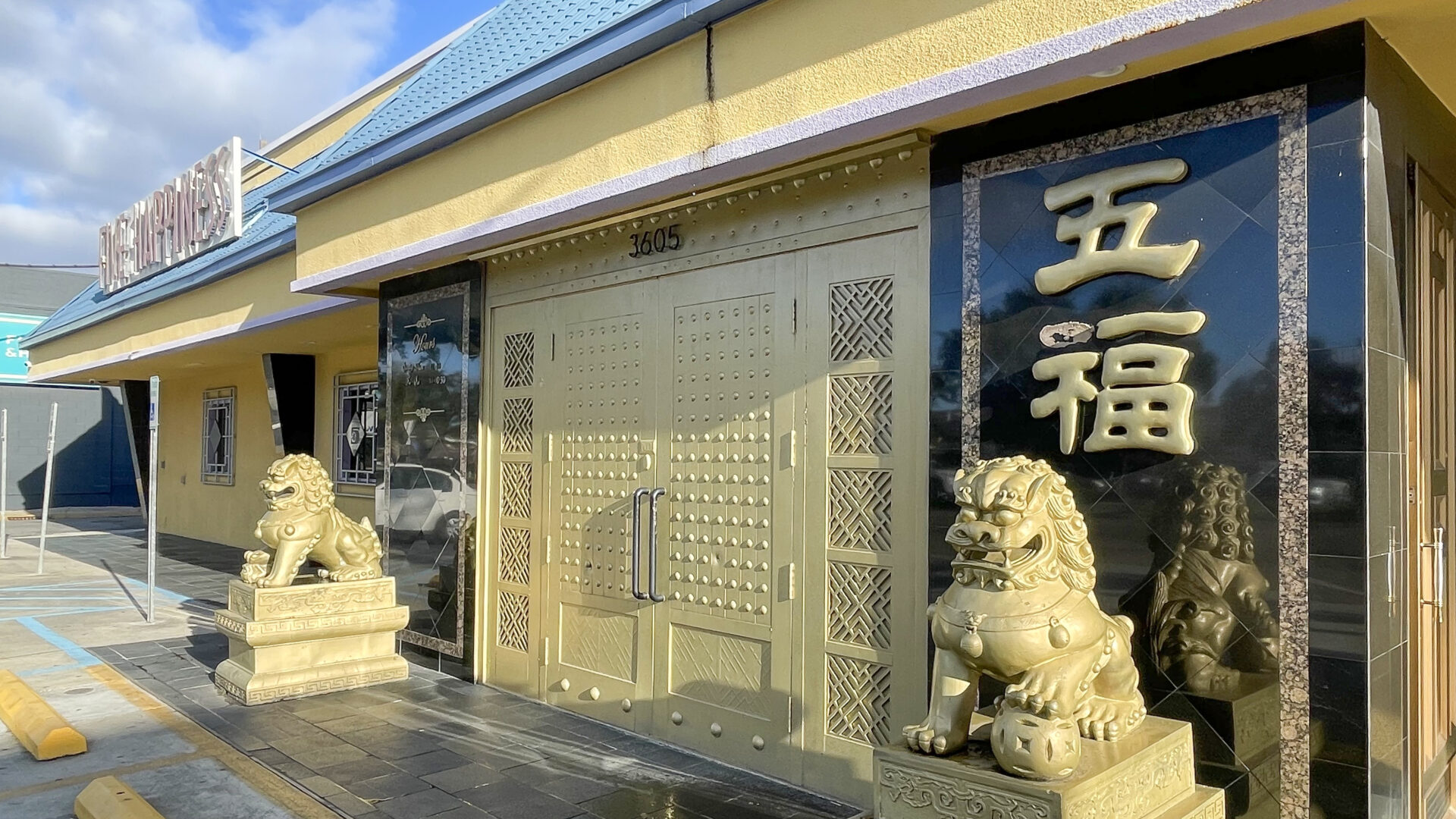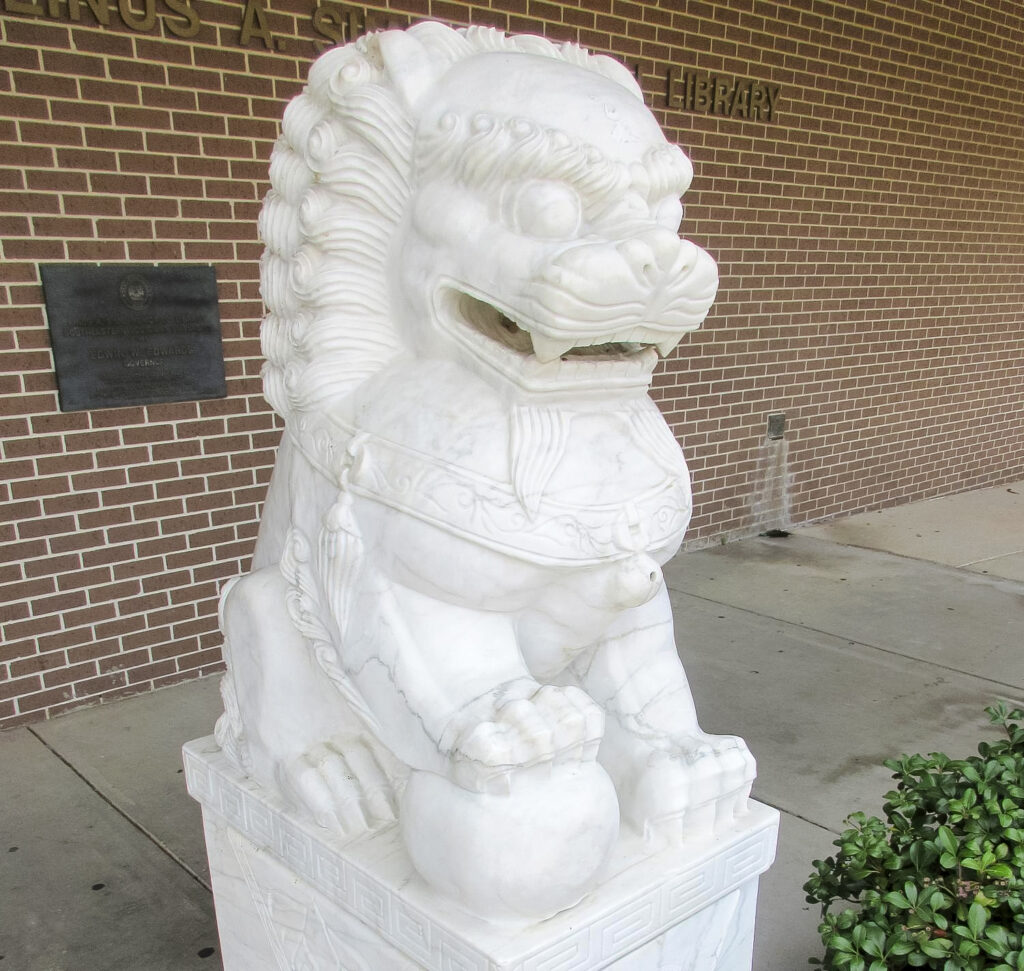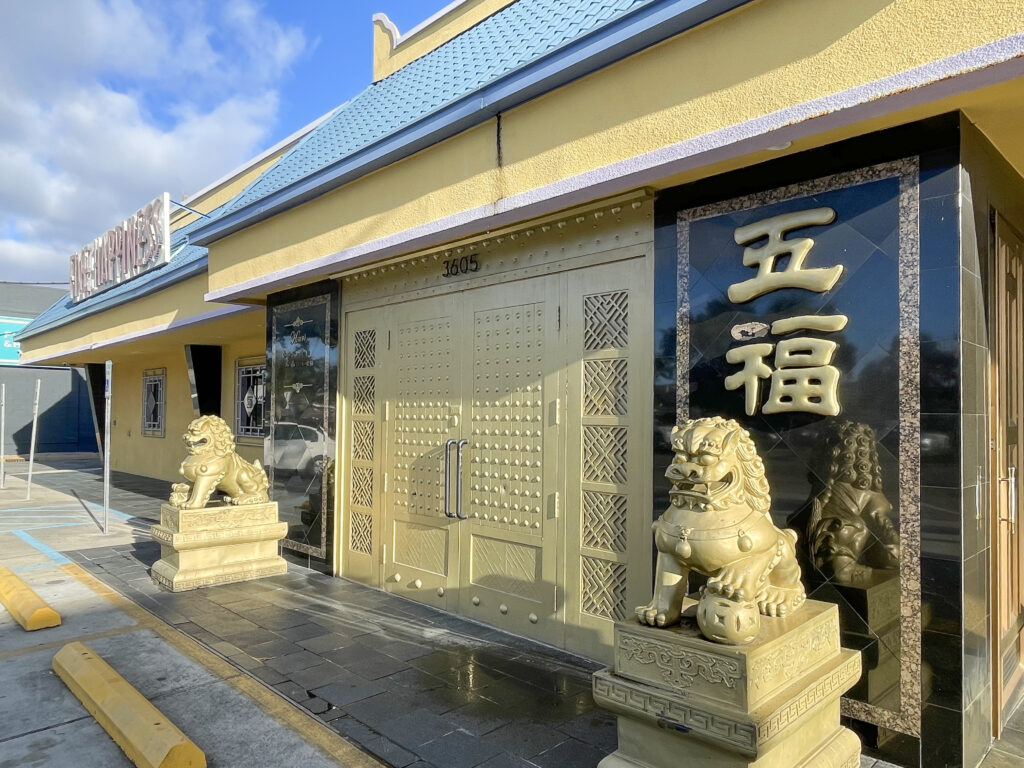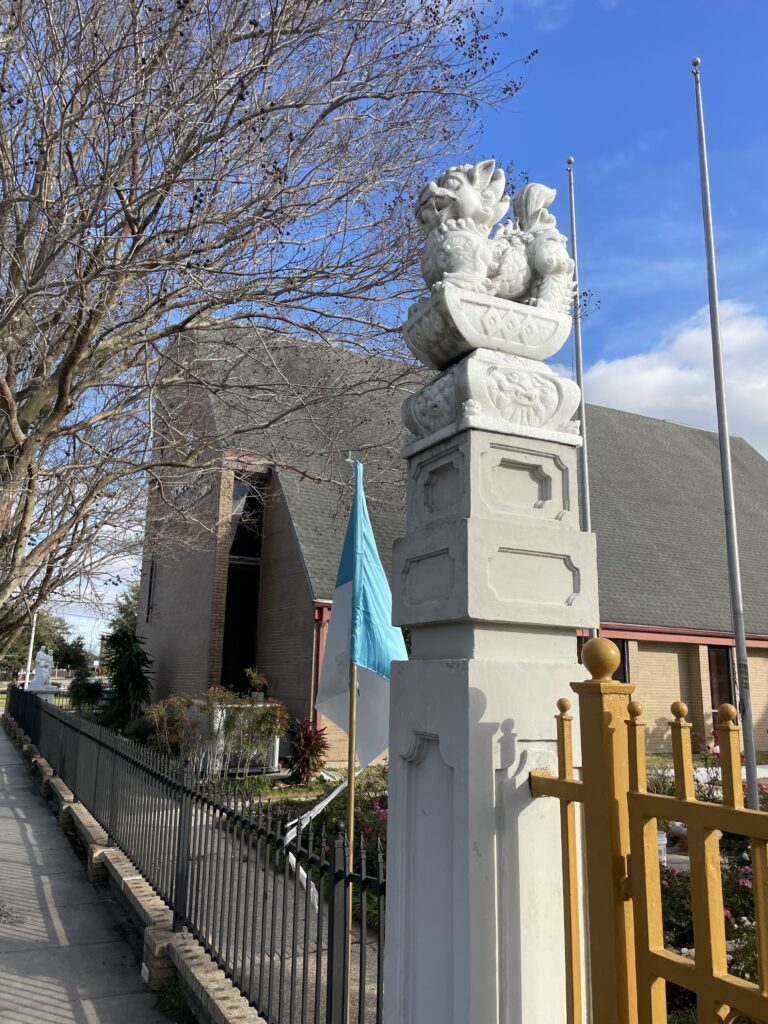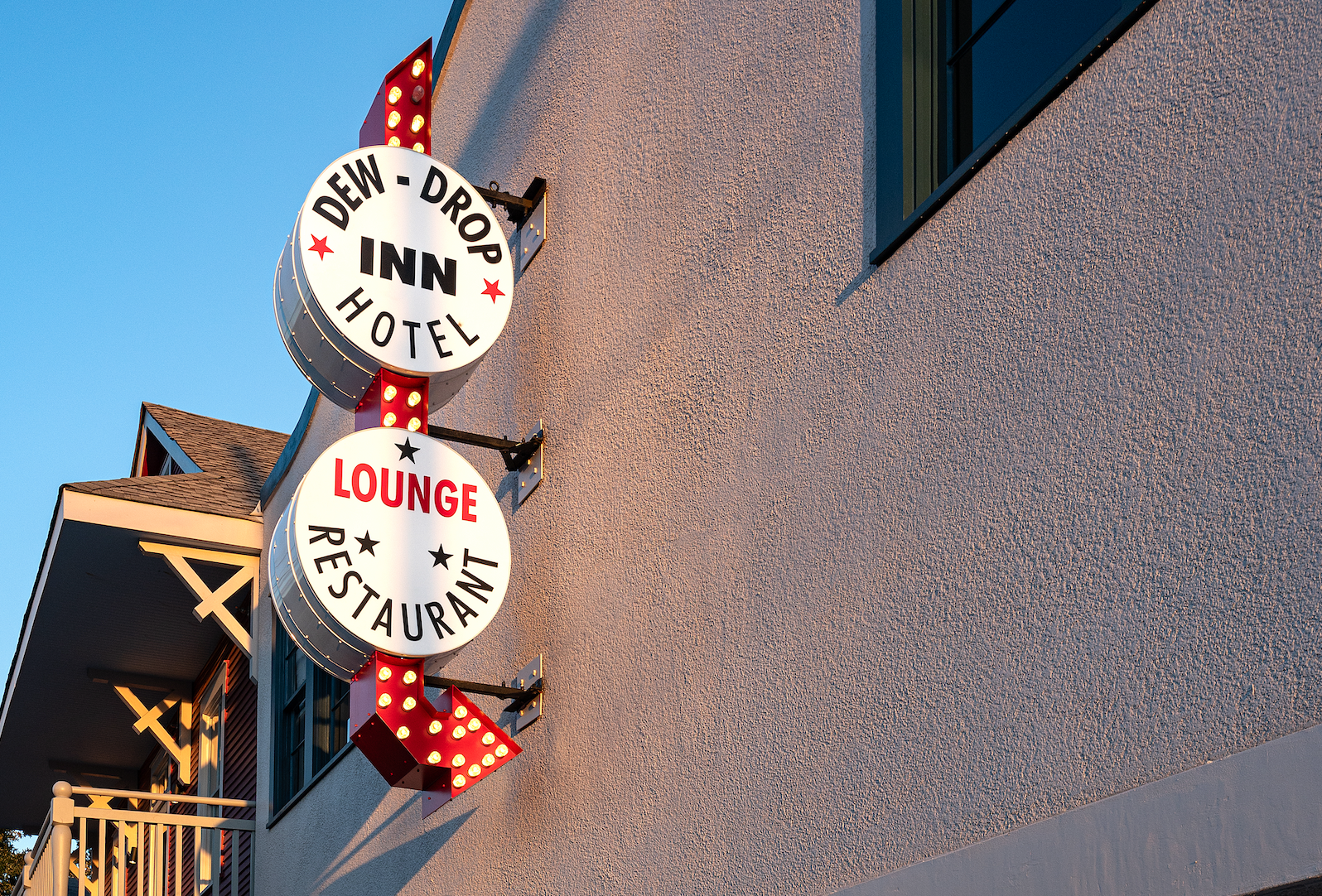This story appeared in PRC’s Preservation in Print magazine. Interested in getting more preservation stories like this delivered to your door? Become a member of the PRC for a subscription!
A pair of Chinese lions, carved from blocks of marble, stand guard in front of the Sims Memorial Library at Southeastern University in Hammond. The five Wong brothers who founded Trey Yuen restaurants on the North Shore had been living in Hammond for two decades when, in 1987, they built a new location for their restaurant there. They wanted to give back to the community, so when they purchased a pair of lions from China for the new restaurant, they purchased an extra pair as a gift to Southeastern Louisiana University.
Guardian lions are a common feature in Chinese and East Asian architecture, and many of the symbolic pieces can be found in the greater New Orleans area. The Five Happiness restaurant on Carrollton Avenue, the Vallon Pagoda House on Napoleon Avenue, the Hong Kong Asian Market in Marrero, the Chua Bo De Buddhist Temple in English Turn, Our Lady of Lavang Catholic Church in Gentilly, and private homes across the region are among the many places protected by these silent guardians.
However, there is one problem with this East Asian obsession with lions: there are no real lions in China.
In fact, lions have never existed in China, except perhaps the ones in zoos today. Instead, the largest predatory cat in China was the tiger, and man-eating tigers once roamed the forests and frontiers of ancient China. Chinese culture is filled with stories of tigers attacking people, and tigers were described as the king of the beasts. Thus, the Chinese use tigers, not lions, as a metaphor for ferocity — as in “fierce as a tiger.”
The Asiatic lion did exist in much of India and the Middle East, until they were hunted to near extinction in modern times. And because of trade along the Silk Road, the Chinese had heard stories of such creatures since the ancient Han Dynasty, though all they really knew was that lions were a large and powerful predator crowned by a mane of long hair. So, in ancient China, lions were a mythical creature, like the dragon or phoenix.
Since the Chinese weren’t sure what lions looked like, Chinese artists had to use their imagination to depict them. Depictions of lions in northern China tended to resemble giant dogs, and early Western travelers described these lions as “fu dogs” or “fortune dogs.” Southern Chinese lions tended to resemble giant cats, which was correct, but only because it was an educated guess.
One of the two marble Chinese lions that stand outside of the Sims Memorial Library at Southeastern University in Hammond. Photo by Nikisun Shrestha, courtesy of The Lion’s Roar at Southeastern Louisiana University.
Five Happiness Restaurant on Carrollton Avenue. Photo by Dee Allen.
Our Lady of Lavang Catholic Church in Gentilly. Photo by Dee Allen.
In traditional Chinese architecture, statues of guardian lions, usually carved from stone or cast from bronze, sometimes painted, are commonly found in front of gates to temples and palaces. They are normally found in pairs, with a male lion holding a ball in one paw, and a female lion holding a lion cub in another paw.
Chinese lions also are commonly found in the lion dance, a tradition that had developed by the medieval Tang Dynasty. Lion dancing was adopted by the Japanese, Koreans, Tibetans, Taiwanese, Vietnamese, and the vast overseas Chinese population in Southeast Asia and beyond, in places like the Philippines, Thailand, Malaysia, Singapore and Indonesia. Like the statues, the lion dance is usually performed by a pair of either dog-like or cat-like lions, which are essentially large puppets animated by two dancers inside each puppet. Like the related dragon dance, musicians with drums and cymbals provide a rhythm for the lion dance, while firecrackers are lit around the lions as an expression of their supernatural power. Invisible demons flee in terror as the sound of the lion dance approaches. A “big headed Buddha” wielding a fan may perform with the lions, clearing a path and holding back crowds.
In Asia, the lion dance is performed during the Spring Festival or Lunar New Year, but it is also performed year-round as a blessing during the opening of a new business or the ground-breaking of a new construction project. The lion dance may even be performed at weddings or to welcome visiting dignitaries.
Apparently, East Asians have the same impulse as New Orleanians to throw a block party for any reason. In Asia, a temporary altar with offerings of food and burning incense may be laid out in front of a building to attract the lions. When the lions arrives, they perform a dance in front of the altar to bless their sponsor. The sponsor may in turn place a red envelope containing money in the mouth of a lion as an act of gratitude — and to tip the dancers. A head of lettuce may be suspended on a pole for the lions to eat, because apparently the ancient Chinese thought the lions craved lettuce. Traditionally, the lion dance was performed by martial artists and acrobats. Thus, there are variations where the lions may dance while balanced on a large ball or walking and jumping on a forest of wooden poles.
So, the next time you pass between a pair of lions when entering a restaurant or the library at Southeastern University, consider yourself blessed. Fortune and happiness will surely follow.
Sources for this article include: Lunar New Year: Lions aren’t native to China, so where did the traditional lion dance come from? By Lisa Cam, Southern China Morning Post, Jan. 25, 2020; “The story behind the library lions,” by Nikisun Shrestha, The Lion’s Roar, Aug. 28, 2018; and Chinese Art: A Guide to Motifs and Visual Imagery, by Patricia Bjaaland Welch. Hong Kong, Tuttle Publishing, 2008.



